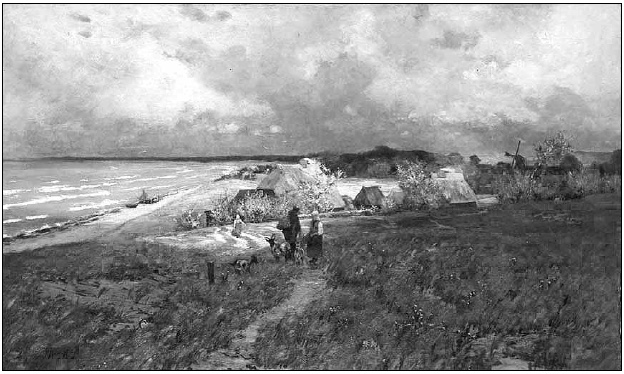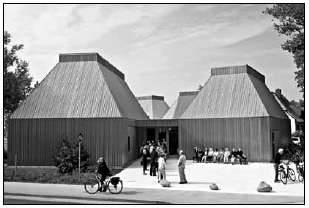“Light, air, freedom” – The Ahrenshoop artists’ colony turns 125
“Light, air, freedom” – The Ahrenshoop artists’ colony turns 125
by Alfried Nehring*
Light, air, freedom – with these signal words, the Ahrenshoop Art Museum celebrates the founding of the “Künstlerkolonie Ahrenshoop” 125 years ago with a big anniversary exhibition this season. Young painters followed the example of their colleague Paul Müller-Kaempff in 1892, who had completed his training with the landscape painters Hans Gude and Eugen Bracht in Berlin, to settle down in the small fishing village on the coast of the Baltic Sea. Among the founding members was the painter Elisabeth von Eicken, who was already very well known at that time. Ladies had no access to the academies and thus the artists’ colony enjoyed a large clientele in their painting schools for ladies from the beginning on. They were of great concern for them and source of income equally for the founders Paul Müller-Kaempff and Friedrich Wachenhusen.

The unusual light between sea and Bodden attracted the painters as well as the clear air, the smell of salt of the Baltic Sea and the freshness of the jungle-like forest, which today still extends from the eastern village exit of Ahrenshoop to the island of Rügen as “Vorpommersche Boddenlandschaft” (Western Pomerania Lagoon Area National Park). Far removed from the regulated and hierarchical art business of the capital, from the hustle and bustle, the narrowness and the destruction of nature, becoming increasingly widespread by a wild industrialisation, they allowed themselves, to use the truth of nature in a still undestroyed uncivilised landscape for the most important measure of their painting. They colonised the small village and its picturesque surroundings by their art.
In simple words Paul Müller-Kaempff has recorded in his memoirs, what fascinated him about Ahrenshoop at that time and how a rather random study trip became a life choice for him: “In the late summer of 1889 I stayed in Wustrow on the ‘Fischland’ with my colleague, the animal painter Oskar Frenzel, to paint sketches. On an occasional hike on the high bank, reaching the last hill, suddenly there lay a village at our feet: Ahrenshoop. Nobody was to be seen, the hoary thatched roofs, the gray willows, and gray dunes gave the whole picture a touch of deepest seriousness and perfect virginity. Nowhere a bleak utility building with a cardboard roof, nothing that disturbed the overall impression, the village road very wide and sandy, no wire fence, no billboard. Behind the village on the Schifferberg the churchyard gazed over with white and black wooden lattices and crosses, overgrown with golden yellow blooming hawkweed. Dunes, forest and lake, in the distance we could see the dark line of the Darss. The dunes crowned with ancient white haw trees, hollies and wild roses. This was a place of study, as I had always wished for.” The idea for one of his most famous paintings, “Alter Schifferfriedhof im Dünen” from 1893 was formed by these impressions.

In the new art museum of Ahrenshoop, created by civic involvement, the painting is always present for the visitors and tourists as a permanent loan from the art gallery at Kiel. It is one of 11 works from the period of the artists’ colony, for which the municipality of Ahrenshoop has built an artistic path with weather-resistant large-format reproductions on the occasion of the founding jubilee on the painters’ former motifs.
As an artist colony, Ahrenshoop has the advantage that its countryside is a magnet for the following generations and artists of European standing. In June of 1911, the Russian painters, Marianne von Werefkin and Alexej von Jawlenski travelled to Prerow, not far from Ahrenshoop on the Baltic Sea, as summer guests. The latter experienced a new beginning in his creativity. He wrote: “I painted in very strong, glowing colours, absolutely the opposite of natural and material. This was the turning point in my art.” Marianne von Werefkin integrated her impressions in colourfully expressionistic paintings “The cliffs of Ahrenshoop” which can be found today in the Museum of Modern Art in Ascona.
In a collection of exhibitions due to the jubilee of the artist colony, the Art Museum Ahrenshoop displays a further exhibition, dedicated to the artistic dialogue between tradition and modern. It seems to be an unusual idea, to confront the paintings of the Japanese artist, Leiko Ikemura, who currently lives in Berlin, with the paintings of the colour magician, Emil Nolde. The double presentation is part of the project “Nolde in the North” which, at the occasion of the 150th birthday of the painter, unifies the Nolde-Foundation in their original building, Seebüll together with nine other North German museums.

Even if Nolde and Ikemura have never met and their paths in life and their work conditions were totally different, the museum’s guest can discover inspiring analogies through the paintings chosen by the curator, Dr Katrin Arrieta. Their realistic landscapes combined with natural experiences are a decided source of their art. As such, they are part of the tradition of landscape painting, as it developed in the 19th century.
Emile Nolde was born in 1867 in his beloved land between seas, Schleswig-Holstein and although he is only 6 years younger than Paul Müller-Kaempff, he stands for a completely new artist generation. As a skilled wood sculptor for the making of furniture, in 1893 he became a teacher for drawing and modelling in the Industry and Trade Museum in St. Gallen. His “Mountain postcards” of the summits which are depicted as figures of legends, sold so well that he decided to become an independent painter.
More than hundred years later Leiko Ikemura transferred her impressions of her studystay in Swiss Grisons in the tradition of Japanese Tuscan painting to a cycle of fairy mountainous landscapes, particularly large and impressive the picture “Genesis – St. Ursula” from 2016, Tempora on canvas. After her studies in Spain, stays in Zurich and Munich, Leiko Ikemura creates the artistic breakthrough in Cologne. In 1987, she received a first large-scale personal exhibition at the “Museum für Gegenwartskunst” in Basel, which today owns more than 100 works by Ikemura.
In 1907, Emil Nolde is chosen by the artist group Brücke as their spokesman because of his expressive coloring. Great successes of his exhibitions also lead to his membership in the Berlin Secession, from which he becomes excluded after an argument with Max Liebermann. His life in the metropolis and the art scene in the capital do not satisfy him. After all he finds the seclusion and inspiration he desired for his work in his own residence in Seebüll. There he created his world-famous still lifes in which “flower scenes” ripen into color-sparkling sensuous art experiences. Between the flower pictures of Ikemura and Nolde an artistic dialogue is also taking place in the exhibition at the Ahrenshoop Art Museum.
During the last 125 years Ahrenshoop has also changed considerably. At the time the artists started a dynamic that changed the remote fishing village to a long term destination for tourists. Nevertheless the local structure from the time of the artists’ colony is still recognisable, the surrounding landscape is largely natural. In the Darss forest, in the dunes of the Baltic Sea and in the meadows of the Bodden you can still feel the genius loci of once.
Even the architecture of the new art museum in Ahrenshoop is an expression of this connection between tradition and modernity. The Berlin-based architect group Staab has put the ensemble of a typical farm with a thatched roof into a modern cubature and covered it with architctural bronze.
By the anniversary year with its many-feceted cultural offerings Ahrenshoop has further consolidated its reputation as an artist’s place and gained charisma. The ties with Switzerland outlined here should be a small example. •
* The author lives in Ahrenshoop. He was a succesful film and television producer and is the author of art books. His biography of the Russioan impressionist Isaak Levitan was presented in Current Concerns from 11 May 2017 (<link en ausgaben nr-11-9-mai-2017 abendglocken-an-der-wolga.html>www.zeit-fragen.ch/en/ausgaben/2017/nr-11-9-mai-2017/abendglocken-an-der-wolga.html).
(Translation Current Concerns)

(picture ma)
